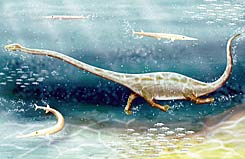why do you have such a long neck
John Noble Wilford New York Times, Haaretz, voila!

An approximate illustration of the marine reptile, whose remains were discovered in southern China. Stretching the neck widened the esophagus and created a suction force
Direct link to this page: https://www.hayadan.org.il/dino271004.html
Giraffes evolved their long necks so that they could climb the tops of trees, far above all potential competitors. This explanation is simple and convincing for the scientists.
It was much more difficult for them to find an explanation for the extremely long neck of some of the early marine reptiles, known as Protorosaurus. The neck length of some of these species was twice the length of their body, and researchers have until now thought that this was the result of unique growth patterns rather than a specific functional adaptation.
Now fossil researchers have discovered another species of Protorosaurus in southern China, and they believe that in these fossils lies the solution to the long neck puzzle. In a report published in the last issue of the journal "Science", the researchers described how the long necks were responsible for the ability of those reptiles to capture their prey in the water.
According to Dr. Olivier Riffle from the "Field" Museum in Chicago, marine animals living in a dense environment such as water encounter a problem that terrestrial animals do not suffer from. In addition to the fact that each of their rapid movements towards their prey serves as a warning signal of the impending attack, it also creates a wave of pressure capable of driving the prey away from them.
The fish and some turtles deal with the problem by eating by suction. They pull the prey into their mouths by rapidly expanding the mouth cavity. It seems that through its long and strong neck, the Protorosaurus species that was discovered - which was named Dinosplosaurus orientalis - was able to solve the problem in a similar way.
The scientists - Dr. Ripple, Dr. Michael LaBarbera of the University of Chicago and Dr. Chan Li, a researcher at the Institute of Vertebrate Fossils and Paleoanthropology in Beijing - concluded that when this marine reptile thrust its head forward toward its prey, it The ribs along his neck outward. This action expanded the diameter of the reptile's esophagus, thus creating a suction force.
This suction force "swallowed" the pressure wave created by the reptile's head thrust, and thus both reduced the risk of warning the prey and also resulted in its being swallowed.
According to Dr. LaBarbera, this is a "method of eating that was not previously known to exist among marine reptiles".
https://www.hayadan.org.il/BuildaGate4/general2/data_card.php?Cat=~~~987677122~~~153&SiteName=hayadan
